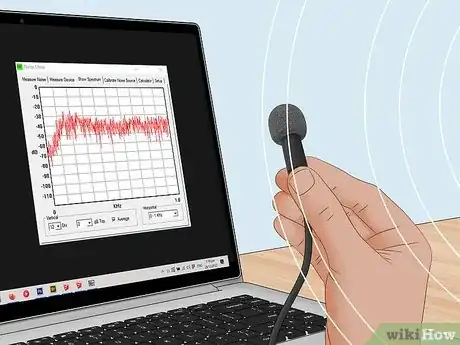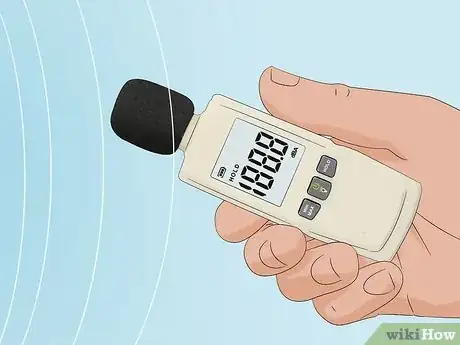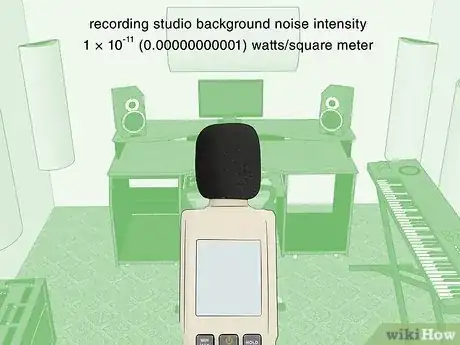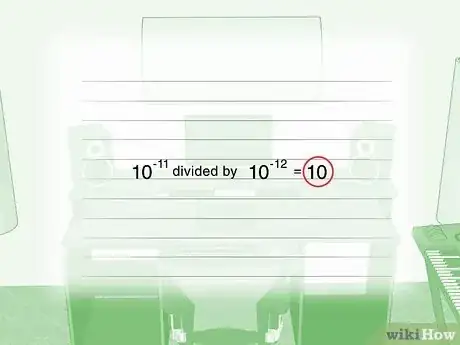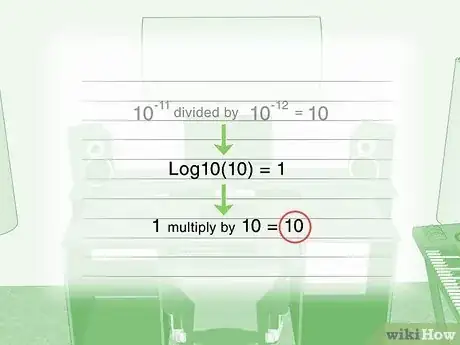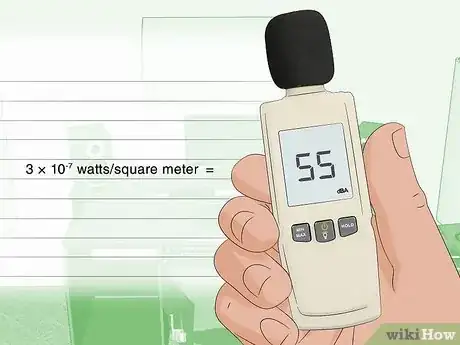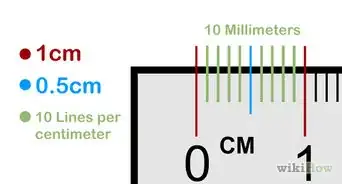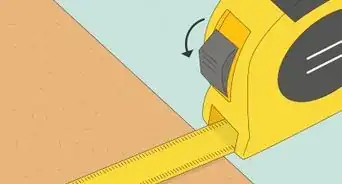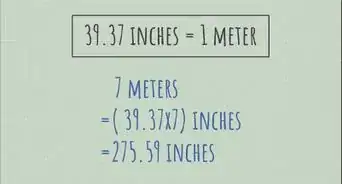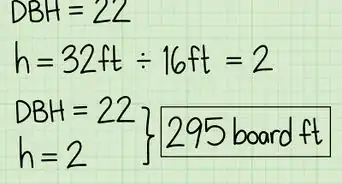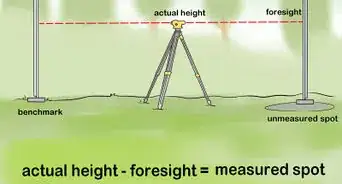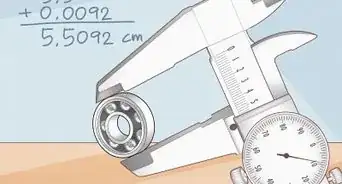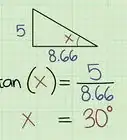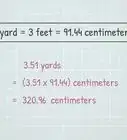wikiHow is a “wiki,” similar to Wikipedia, which means that many of our articles are co-written by multiple authors. To create this article, 26 people, some anonymous, worked to edit and improve it over time.
There are 10 references cited in this article, which can be found at the bottom of the page.
This article has been viewed 338,057 times.
Learn more...
In common usage, decibels are usually a way to measure the volume (loudness) of a sound. Decibels are a base 10 logarithmic unit, which means that increasing a sound by 10 decibels results in a sound that is twice as loud as the "base" sound. In general terms, a sound's decibel value is given by the formula 10Log10(I/10-12), where the number one represents the sound's intensity in watts/square meter.
Steps
Decibel Noise Comparison Chart
In the table below, rising decibel levels are assigned to common sources of noise. In addition, information on hearing damage from exposure to each level of noise is given.
| Decibels | Example Sources | Health effects |
|---|---|---|
| 0 | Silence | None |
| 10 | Breathing | None |
| 20 | Whispering | None |
| 30 | Quiet rural background noise | None |
| 40 | Library noises, quiet urban background noise | None |
| 50 | Relaxed conversation, ordinary suburban activity | None |
| 60 | Busy office or restaurant noise, loud conversation | None |
| 70 | TV volume, Freeway traffic at 50 feet (15.2 meters) | None; unpleasant for some |
| 80 | Factory noise, food processor, car wash at 20 feet (6.1 meters) | Possible hearing damage after lengthy exposure |
| 90 | Lawn mower, motorcycle at 25 feet (7.62 meters) | Likely hearing damage after lengthy exposure |
| 100 | Outboard motor, jackhammer | Serious damage likely after lengthy exposure |
| 110 | Loud rock concert, steel mill | May be immediately painful; damage after lengthy exposure very likely |
| 120 | Chainsaw, thunderclap | Usually immediately painful |
| 130-150 | Jet takeoffs on aircraft carrier deck | Immediate hearing loss or eardrum rupture possible |
Measuring Decibels with Instruments
-
1Use your computer. With the right programs and equipment, it's not difficult to measure the decibel level of a sound using your computer. Listed below are just a few ways to do this. Note that better recording equipment will always give you better results — in other words, while your computer's default internal microphone may be sufficient for some tasks, a high-quality external microphone will be much more accurate.
- If you're on Windows 8, try downloading the free Decibel Reader app from the Microsoft App store. The app uses your computer's microphone to read noises up to 96 decibels. Similar devices are available from the iTunes app store for Apple products.[2]
- You can also try using a third-party program to measure decibels. For instance, Audacity, a free sound recording program, includes a simple built-in decibel meter.
-
2Use a mobile app. For measuring sound levels on the go, mobile apps can be extremely convenient. Though the microphone on your mobile device isn't as likely to be as high-quality as the sorts of external mics you can connect to a computer, they can be surprisingly accurate. For instance, it's not uncommon for readings from mobile apps to be within 5 decibels of the readings from professional equipment.[3] Below is a brief list of decibel-reading apps available for common mobile platforms:
- For Apple devices: Decibel 10th, Decibel Meter Pro, dB Meter, Sound Level Meter
- For Android devices: Sound Meter, Decibel Meter, Noise Meter, decibel
- For Windows phones: Decibel Meter Free, Cyberx Decibel Meter, Decibel Meter Pro
Advertisement -
3Use a professional decibel meter. Though it's not usually cheap, perhaps the most direct, accurate way to find the decibel level of a sound you with to analyze is to use a decibel meter. Also called a "sound level meter", this specialized tool (available from online retailers and specialty stores) uses a sensitive microphone to measure the amount of noise in the environment and give you a precise decibel value. Since there isn't generally a large market for these tools, they can be somewhat expensive — often at least $200 even for low-cost models.[4]
- Note that decibel meters/sound level meters can go by other names. For instance, another type of tool called a "noise dosimeter" performs basically the same function as a standard sound level meter.
Deriving Decibels Mathematically
-
1Find your sound's intensity in watts/square meter. For everyday practical purposes, decibels are usually seen as a simple measure of loudness. However, the truth is a little more complex. In physics, decibels are often thought of as a convenient way of expressing the intensity of a sound wave. The larger the amplitude of a given sound wave, the more energy it transmits, the more it moves the air particles in its path, and the more "intense" the sound is.[5] Because of this direct relationship between a sound wave intensity and its volume in decibels, it's possible to find a decibel value given nothing more than an intensity level for the sound (which is typically measured in watts/square meter)
- Note that, for ordinary sounds, the intensity value is usually very small. For instance, a sound with an intensity of 5 ×10-5 (or 0.00005) watts/square meter translates to about 80 decibels — about the volume of a blender or food processor.
- To better understand the relationship between intensity measurements and decibels, let's follow along with an example problem. For the purposes of this problem, let's say that we're music producers and we're trying to find the background noise level in our recording studio to improve the sound of our records. After setting up our equipment, we detect a background noise intensity of 1 × 10-11 (0.00000000001) watts/square meter . In the next few steps, we'll use this info to find the decibel level of the background noise in our studio.
-
2Divide by 10-12. Once you've found the intensity of your sound, you can simply plug it into the formula 10Log10(I/10-12) (where "I" is your intensity in watts/square meter) to find its decibel value. To begin, divide by 10-12 (0.000000000001). 10-12 represents the intensity of a 0 decibel sound, so by comparing your intensity value to this, you're essentially finding its relationship to this base value.
- In our example, we'd divide our intensity value, 10-11, by 10-12 to get 10-11/10-12 = 10.
-
3Take the Log10 of your answer and multiply by 10. To finish solving, all you need to do is take the base 10 logarithm of your answer, then, finally, multiply by 10. This accounts for the fact that decibels are logarithmic units with a base of 10 — in other words, an increase of 10 decibels means that the loudness of the sound has doubled.
- Our example is easy to solve. Log10(10) = 1. 1 ×10 = 10. Therefore, the background noise in our studio has a loudness of 10 decibels. This is quite quiet, but still detectable with our high-quality recording equipment, so we'll probably need to eliminate the source of the noise for the best recordings
-
4Understand the logarithmic nature of decibel values. As noted above, decibels are logarithmic units with a base of 10. For any given decibel value, a noise 10 decibels greater is twice as loud, a noise 20 decibels greater is 4 times as loud, and so on. This makes it easy to describe the huge range of sound intensities that can be picked up by the human ear. The loudest sound the ear can hear without experiencing pain is more than one billion times more intense than the quietest noise it can detect.[6] By using decibels, we avoid having to use huge numbers to describe common sounds — instead, we only need to use three digit numbers at most.
- Consider this — which is easier to use: 55 decibels or 3 × 10-7 watts/square meter? The two are equivalent, so rather than having to use scientific notation (or a very small decimal), decibels allow for us to use a sort of simple shorthand for easy everyday use.
Community Q&A
-
QuestionA a boy screeches at high levels into other children's ears, is he hurting their hearing?
 Community AnswerYes.
Community AnswerYes. -
QuestionI'm in a duplex, and the neighbor's music is vibrating things off my wall. Is this too loud?
 Community AnswerThat is probably too loud, especially if it is bothering you.
Community AnswerThat is probably too loud, especially if it is bothering you. -
QuestionMy neighbor has a sound system in his garage that no one can hear but one person in my house. It causes a pressure in their head. What can it be?
 Community AnswerThat is quite odd if they are playing it quietly. It could be something completely unrelated to the sound system. Perhaps ask the neighbor to turn it off and see if your housemate still hears things.
Community AnswerThat is quite odd if they are playing it quietly. It could be something completely unrelated to the sound system. Perhaps ask the neighbor to turn it off and see if your housemate still hears things.
References
- ↑ https://www.chem.purdue.edu/chemsafety/Training/PPETrain/dblevels.htm
- ↑ https://itunes.apple.com/us/app/decibel-10th/id448155923?mt=8
- ↑ https://itunes.apple.com/us/app/decibel-meter-pro/id382776256?mt=8
- ↑ https://www.noisemeters.com/product/tm102/sound-meter.asp
- ↑ http://www.physicsclassroom.com/class/sound/Lesson-2/Intensity-and-the-Decibel-Scale
- ↑ http://www.physicsclassroom.com/class/sound/Lesson-2/Intensity-and-the-Decibel-Scale
- ↑ http://www.rapidtables.com/electric/watt.htm
- http://www.gcaudio.com/resources/howtos/loudness.html
- http://hyperphysics.phy-astr.gsu.edu/hbase/sound/db.html
About This Article
To measure decibels, download a mobile decibel-reading app, like Sound Level Meter or Decibel Meter. You can also measure decibels using computer programs like Audacity or Decibel reader. Another option is to use a profession decibel meter, which can give you a very accurate decibel reading. For a handy chart showing the approximate decibel levels for common noises, read on!
